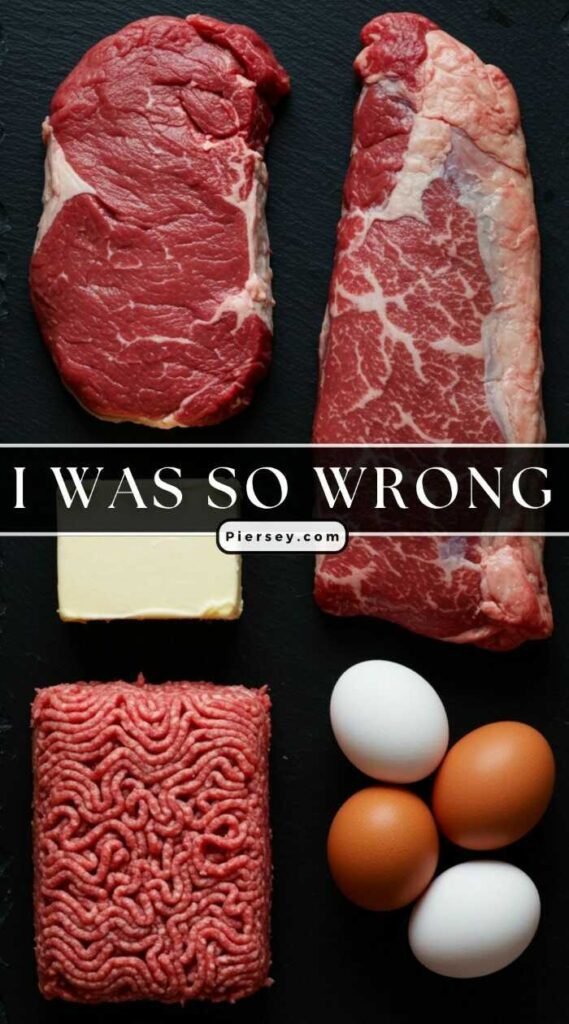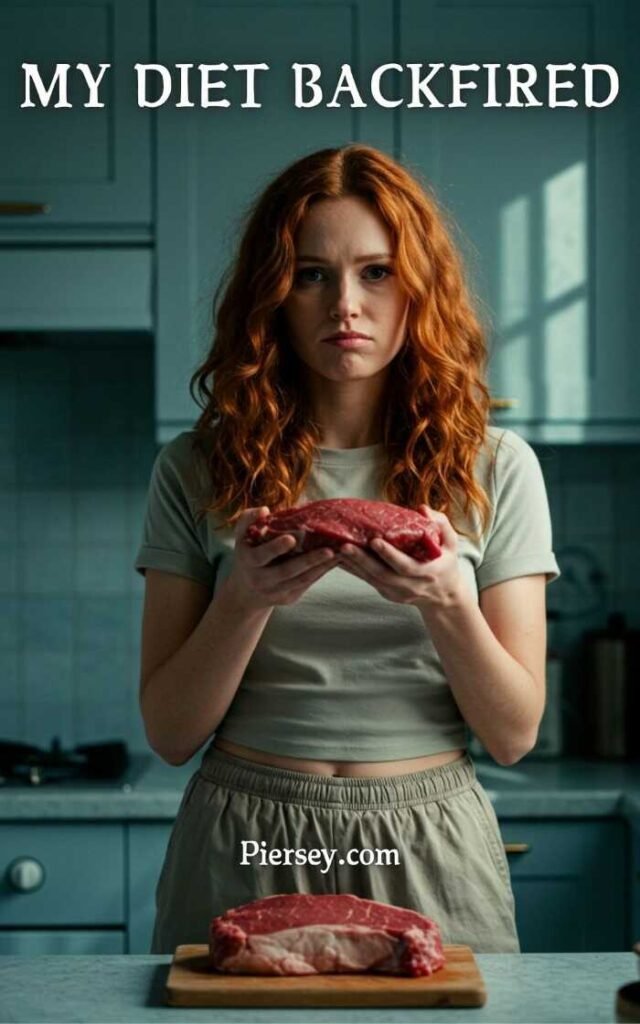Most people assume fatty liver disease comes from sugar, alcohol, or junk food. You know, the usual suspects — pizza, soda, late-night snacks.
But here’s the twist: I developed fatty liver after almost ten years of eating nothing but red meat, eggs, and water. Yep — no sugar, no bread, no alcohol binges. Just beef, lamb, and the occasional black coffee.
At first, I thought I’d found the perfect diet. Keto had worked wonders — my energy went up, brain fog cleared, and my weight dropped fast. Then I took things further and went full carnivore. It felt simple, clean, and “natural.” But as I’d later learn, simplicity can still be dangerous when your body plays by different rules.
👇 If you’d rather watch the video version, it’s right below 👇
My Health Starting Line
I’ve never exactly been the “textbook healthy” type. I was born with thalassemia trait, which basically means my red blood cells are small and don’t carry oxygen as efficiently. I’ve always had that built-in low-energy feeling — not lazy, just physiologically slower.
Then came hypothyroidism, diagnosed when I was about fifteen. My thyroid was underactive, my metabolism sluggish, and my energy crashed constantly. I remember feeling like a 40-year-old trapped in a teenager’s body. I’d wake up tired, gain weight just looking at food, and somehow ended up over 250 pounds without any crazy eating habits. Walking around the house felt like a workout.
So right from the start, my body was working uphill. I had sluggish blood, a slow thyroid, and a tendency to gain weight even on air. That combination shaped everything that came next.
How Low-Carb Took Over My Life
When keto first came along, it was a revelation. I finally felt in control. The pounds started dropping, my energy improved, and my mind felt razor sharp. I became obsessed — reading studies, watching YouTube doctors, doing all the “biohacker” things.
Then came the carnivore phase. Around 2020, I went all in: roughly two to three pounds of beef or lamb every day. Eggs on repeat. Virtually no carbs. Poultry and fish were rare guests, and anything that grew in the ground or on a tree might as well have been forbidden fruit.
Was I strict? Pretty much. The occasional cheat was a small punnet of berries or a diet coke once a month. I drank black coffee, filtered water, and sparkling water like it was a personality trait. Looking back, I was probably 99% carnivore — and I was proud of it.
The thing is, it worked… until it didn’t.


When Things Started to Shift
After several years, I started noticing subtle changes — slower recovery, heavier fatigue, and that strange sense that my metabolism was dragging its feet again. My thyroid medication dose kept creeping up until I hit 150 micrograms of thyroxine, the highest I’d ever needed.
Then, in 2024, I had spine surgery. The recovery process basically put my metabolism in slow motion. I went from being decently active to sitting or lying down most of the day. And because I wasn’t moving, the same carnivore portions that once maintained my weight started to pack it on — one to two pounds a week, slow but steady.
Even then, I didn’t suspect my liver. My mindset was still “fat is fuel” and “carbs cause problems.” I just figured my metabolism was shot from surgery. If you’ve ever hit a frustrating weight plateau, you’ll get what I mean.
The Aches I Couldn’t Ignore
Fast-forward to the summer of 2025. I began feeling this dull, nagging ache under my right ribcage. It wasn’t pain exactly — more like an occasional pressure that came and went. At first, once or twice a day. Then ten, maybe twenty times a day.
You know when something in your body just feels off? That’s what it was. Eventually, I got it checked. Blood tests, ultrasound, then a CT scan. The diagnosis: fatty liver disease.
It took me a minute to process that. I didn’t drink, didn’t eat sugar, didn’t live off junk. How on earth could I have a fatty liver?
The answer, as it turns out, was iron.
The Perfect Storm Inside My Body
Normally, your body uses iron to make haemoglobin — that’s what lets your red blood cells carry oxygen. But because of my thalassemia, my cells don’t form properly. So even though my iron intake was massive from all that red meat, my body couldn’t use it efficiently. It just stored it — mostly in the liver.
It’s like having a garage full of bricks but no builders to make the house. Over time, those “bricks” (iron) started piling up. My ferritin levels rose, my haemoglobin stayed low, and the liver took the hit. Combine that with years of high dietary fat and low carbs, and my body had the metabolic version of a traffic jam.
Why This Combo Was So Dangerous
Most carnivores never run into this because they don’t have the same genetic setup. My situation was rare:
• Thalassemia trait → low haemoglobin
• Hypothyroidism → sluggish metabolism
• Heavy red meat → high iron exposure
• High fat intake → extra stress on the liver
That’s the formula that created my “perfect storm.”
I had too much iron stored, too little oxygen moving through my blood, and a metabolism already running at half speed.
Trying to Fix the Damage
A few years ago, I’d seen doctors online talk about blood donation as a way for men on high-meat diets to reduce iron levels. I started donating every few months — roughly ten times over three or four years. Each donation pulled out about a pint of blood, and for a while, that worked beautifully.
Then, three failed donations in a row. My haemoglobin was too low. I was struck off the donor list entirely. So there I was: can’t eat red meat (too much iron), can’t donate blood (too little haemoglobin). It’s the definition of a catch-22.
Now, under my doctor’s advice, I’ve cut out red meat completely. These days, I’m eating high-carb and low-fat — basically the total opposite of where I started. The focus isn’t just weight loss anymore; it’s healing my liver and rebuilding my health. If you want to see what that actually looks like day to day, take a peek at what my current rice-and-carb routine looks like here.
I’ve got a consultant appointment coming up to talk about treatment options, including possible iron-chelating medication if my ferritin doesn’t drop naturally.
Lessons I Wish I Knew Earlier
Honestly, this whole experience has been humbling. Carnivore and animal-based diets can work incredibly well for some people — I’ve seen it firsthand. But genetics change the game. What’s “optimal” for one body can be toxic for another.
For years, I believed I was doing everything right — clean food, disciplined eating, zero processed junk. But that didn’t make me immune to imbalance.
If I could go back, I’d have checked my ferritin and liver enzymes yearly instead of assuming that good energy meant good health.
It’s strange — I used to think carbs were the enemy. Now they’re part of what’s helping me heal. I’m not chasing ketosis or macros anymore. I’m chasing balance and sustainability.


Where I’m At Now
These days, my meals look totally different — rice, fruit, beans, vegetables, and lean proteins like white fish. My workouts are slow and intentional. I’m rebuilding, not punishing my body.
I still believe in self-experimenting, but with one big rule: don’t ignore your blood work just because you feel fine. I learned that lesson the hard way.
So, if you’re deep into carnivore or keto and feeling invincible, that’s great — but keep an eye on the details. Check your iron, thyroid, and liver enzymes. Your body’s giving you data all the time; it’s just up to you to listen.
I can’t change the blood I was born with, but I can change how I treat it. If my story makes even one person take their labs a little more seriously, then sharing it was worth it.
And if you’re curious to see how this all played out — the diet experiments, the ups, the downs, and everything in between — you can catch the full story over on my YouTube channel. That’s where I share all the behind-the-scenes moments, honest updates, and what’s actually working for me right now.



